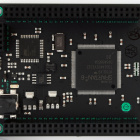Big Daddy Mike
Member Since: November 23, 2009
Country: United States
-
In the example below, I think Part 1 needs to read Part 1 - Divide 61453 by 16. The result is a quotient of 3840, and a remainder of 13. That remainder becomes our first, RIGHT-most, least-significant hex digit – D. Take 3840 to the next step.
Decimal-to-Hex Example: Convert 61453
Enough math-speak, let’s work an example. Let’s convert 6145310 to hexadecimal:
Part 1 - Divide 61453 by 16. The result is a quotient of 3840, and a remainder of 13. That remainder becomes our first, left-most, least-significant hex digit – D. Take 3840 to the next step.
Now divide 3840 by 16. The resulting quotient is 240 with a remainder of 0. Our second hex digit is 0, and we take 240 to the next digit.It's confusing enough even without dyslexia and I'm not ambidextrous. ; )
-
Yes - I used to work for a Danaher company and this does not surprise me. FYI - Danaher also owns Craftsman (hand tools), which is marketed/sold through Sears.
-
If you ever make it to Haiti - be prepared to drive on both sides of the street - anyone who has been there knows exactly what I'm talking about. They will drive anything with a steering wheel regardless of what side it is on. ; )
-
That is so AWESOME - I look forward to reading the blog immediately!
-
Sounds a lot like a modern day PLC. It used to be switches and relays in a cabinet, now it's a box with ladder logic software to create the same thing.
-
I have never tried to 'program' an FPGA, but I did just learn how to program a PLC in ladder logic. I have programmed many things in basic like languages for years as well as programmed ucontrollers for several projects. The shift to programming a machine in ladder logic was fairly big. You can have several parallel process running and it 'seemed' much more difficult to "control" what was going on. As I learned more and more, I found that it was much easier to add certain types of functionality with ladder logic since I knew that bit of 'code' would alwys run regardless of what else was going on in the 'program'
Bottom line is that ladder logic (similar to what I understand about VHDL, etc.) IS a pictorial view of hardware that used to exist as switches and relays. I'm not sure of the hardware used inside a PLC, but the implementation of programming it is very different from traditional line by line code. Some may call it BAD, but I just call it 'different'.
-
A long overdue tribute to Gordo the space monkey. Dave is a dead ringer for Gordo, RIP Gordo! http://en.wikipedia.org/wiki/Gordo_%28space_monkey%29
-
I am a "fit it myself" kind of guy. I have repaired our 50" brand name projection HDTV more than once. I paid for the service manual (on-line) and ordered the replacement parts (on-line) and the TV still works today (despite the cajoling of my wife to get a new one). What's the crime in that? Isn't that how it always worked before the internet? Ingenuity served those well willing to take the risk of breaking something permanently?
Maybe big companies should go back to making products that work for more than the warranty period instead of trying to keep up with "seasonal fashions".
Just my $0.02
-
I got mine today and they worked fine once I swapped A & B on the RS 485 end. The Rx and Tx lights are also backwards for my application.
-
Yeah - I agree - my wife always tells me how much she SAVED while shopping at Target or JC Penney.....
; ^ )
No public wish lists :(






